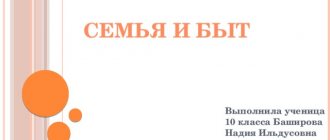CAREER GUIDANCE PROJECT for younger schoolchildren “Diverse world of professions” project (4th grade)
Slide 1
Project “Career guidance work in elementary school” Completed by: Dubrovkina E.V.
Slide 2
Main idea: Career guidance work in elementary school prepares the “soil” for a more meaningful and informed professional choice in middle and senior levels.
Slide 3
The goal of the project is to develop experience in various types of activities, interest and a positive attitude towards work, study inclinations, and expand knowledge about the world of professions.
Slide 4
Objectives: - expanding initial ideas about various professions; — providing students with the opportunity to immerse themselves in various professions through game situations; — development of interest in various professions; - fostering hard work and respectful attitude towards other people’s and one’s own work; - identifying the areas of interests of children and enriching this area; — development of the abilities of younger schoolchildren based on various impressions about the world of professions; - study of attitudes towards learning and academic subjects.
Slide 5
Early career guidance work should be carried out already in elementary school, because It is at this stage of education that students lay the foundations for choosing a future profession. Introducing younger schoolchildren to a variety of professions will allow them to make the right and informed choice in the future. One of the tasks of teaching and educating junior schoolchildren in accordance with the implementation of the Federal State Educational Standard of Education is preparation for an informed choice of profession.
Slide 6
Vocational guidance is not a student’s choice of a profession, one for life, but the formation of his readiness for professional self-determination, the activation of the internal resources of his personality so that, when involved in professional activities, a person can fully realize himself in it. Career guidance is a system of activities aimed at identifying the personal characteristics, interests and abilities of students in order to assist in the wise choice of professions that best suit their individual capabilities. Project content:
Slide 7
Age characteristics Increased sensitivity to external influences; Leading activity – educational; Study is guided by the motive of interest, curiosity, and the desire to achieve approval from adults.
Slide 8
Age characteristics 4. The volitional sphere is insufficiently developed, thinking is of a visual and effective nature; 5. Self-esteem and self-confidence are formed in activities under the influence of adults; 6. The child must feel the significance and purposefulness of his work.
Slide 9
is a system of pedagogical influence on students both in class and outside of class time to prepare them for a conscious choice of profession. The main directions of career guidance work in elementary school are: - helping junior schoolchildren in choosing the direction of activity in which they would like to realize themselves; - expanding the range of modern professions and their importance in life. Vocational guidance at school
Slide 11
The purpose of career guidance in the 1st grade is to develop the first skills of general work for the benefit of a person, work culture, expand knowledge about the production activities of society, about technology, cultivate respect for people who work, and understand the importance of work in human life. In the 2nd grade, younger schoolchildren also continue to become acquainted with the work of those around them and have a deeper understanding of some professions. Second grade students are trying to establish relationships in work groups. are engaged in mastering various skills and habits of work.
Slide 12
continue to deepen general labor knowledge, skills and abilities. At this age, one becomes familiar with the work of the people around them and their professions, and begins to develop the first skills of organizing one’s own work and the work of classmates. Third graders show activity and initiative in searching for and implementing useful things. During this period, a sense of responsibility for the quality of the work performed occurs. Third grade students
Slide 13
Students in grade 4 generalize and expand their ideas about work acquired in previous grades. At this age, the cultivation of love for work and respect for working people continues. Their understanding of the diversity of professions deepens. Career guidance work gives junior schoolchildren the opportunity to try themselves in various activities. The use of their experience and hobbies allows students to better understand what they like best and what their predisposition is.
Slide 14
In elementary school, various forms of career guidance work are distinguished: 1) organization of career guidance work in the classroom; 2) organization of career guidance work outside of school hours: - excursions; — themed classroom hours; - conversations with children; — projects; — competitions; - games; - extracurricular activities.
Slide 15
The main form of career guidance work for younger schoolchildren is a game. At extracurricular events, it is necessary to use role-playing and complex games that combine elements of theatricalization and staging, the purpose of which is to help expand and deepen the knowledge of junior schoolchildren about professions. Children take part in them with pleasure, playing out the actions. It is advisable to include career guidance games in the structure of primary school lessons, which will allow you to diversify the lessons and make them emotionally rich.
Slide 16
There are many career guidance games that are offered to primary schoolchildren in the classroom and during extracurricular activities. Conventionally, these games can be divided into 4 types: I. Flirting games are played with the aim of training memory, attention and ingenuity. “Name your profession.” One of the students names any profession (for example, teacher). Then the next student names a profession whose name begins with the last letter, i.e. speech therapist.
Slide 17
II. Games that simulate aspects of professional activity are held to familiarize students with the characteristics and requirements of professions. "My ideas." Students have a table with two columns in front of them. In the first, students should write down ideas about the profession at the beginning of the lesson, in the second - ideas about the profession at the end of the lesson. After everyone has filled out the table, everyone reads out their answers. Next comes discussion, clarifications and additions.
Slide 18
III. Games that simulate the construction of a personal professional plan. The purpose of such games is to introduce students to the procedure for correctly constructing personal professional plans, as well as to teach younger schoolchildren to provide career guidance assistance to their classmates. "Consultant". The teacher asks to be divided into pairs. One of the students will be appointed as a consultant, and the other will be on his own. The student has a piece of paper on his desk with questions: “What profession would you recommend to me?” Why? - Name its pros and cons, etc. The consultant must answer questions and convince the student of choosing this profession.
Slide 19
IV. Games are “life activities”. The goal is to introduce students to the content and history of various professions. Such games are held in special conditions: a trip to production, to an institution, etc. Thus, work on career guidance in elementary school through games is aimed at ensuring that schoolchildren learn to navigate a large number of professions and determine their interests.
Slide 20
With 4th grade students, it is advisable to use a form of career guidance work such as psychological diagnostics, the purpose of which is to study the interests, inclinations and abilities of students. The results of this psychodiagnostics can be used when recruiting specialized 5 classes. Currently, career guidance diagnostic tools for primary school age are practically absent.
Slide 21
Methodology “Who to be” (N.S. Pryazhnikov) Draw who you would like to become, write a signature under the drawing.
Slide 22
Results of the “Who to Be” method (N.S. Pryazhnikov)
Slide 23
We propose to use the following psychodiagnostic methods in career guidance work with 4th grade students: 1. Group intellectual test GIT. (Allows you to assess the level of development of logical, mathematical, language abilities) 2. Differential diagnostic questionnaire (DQ) E.A. Klimova. Designed to diagnose the professional interests of children. .
Slide 24
3. Methodology “Studying attitudes towards learning and academic subjects.” Developed by G.N. Kazantseva and is intended for a qualitative analysis of the reasons for the preference for certain subjects and motives for learning. 4. Methodology “Spheres of interests of students” (modification of O.I. Motkov’s method) Using qualitative analysis, it is determined which types of interests are preferable for a student. Leading interests, the presence of interest in active activities, and the relationship between passive and active interests are identified.
Slide 25
Extracurricular career guidance work In order for a child to consciously make a choice in adult life, he must be introduced to the maximum number of professions, starting with his immediate environment, i.e. with professions of people who are well acquainted, whose work children observe every day. For example:
Slide 26
Extracurricular career guidance work Introduction to the profession of a librarian in the district library
Slide 27
Extracurricular career guidance work Introduction to the computer science classroom and the work of a computer science teacher
Slide 28
Extracurricular career guidance work Introduction to the home economics classroom and the work of a technology teacher 4th grade
Slide 29
Conclusion The more professions a child is familiar with and the broader his understanding of the world of professions, the fewer mistakes he will make in the future in the process of forming a professional plan.
The importance of early career guidance
Vocational guidance helps high school students choose a profession or direction of study. It is presented in the form of a system of activities carried out in grades 9-11. It should not be confused with professional self-determination - a rather complex and lengthy process of developing the student’s subjective readiness to make a choice of the type of activity that he intends to engage in in the future. Today, most often, conversations about future employment in schools begin only in grades 8-9, neglecting the laws of the child’s psychological development. Naturally, one cannot expect a conscious and deliberate choice of profession from him. In other words, we start building a house from the upper floors, and then we are sincerely perplexed as to why nothing comes of it. But the foundation needs to be laid in preschool age and continued to be strengthened in the lower grades.
Students should take their first steps in professional self-determination in elementary school, so it is optimal that early career guidance is carried out during this period. At the age of 7-10, children do not yet divide types of activities into “prestigious” and “non-prestigious”, so their range of professional preferences is much wider than that of high school students. Already from the first grade, it is necessary to form a child’s awareness of the importance of each profession, to cultivate responsibility and love for work.
The role of universities
Since 2012, the National Research Technological University (NUST) MISIS has been implementing a comprehensive program of professional navigation, in which more than 170 thousand schoolchildren from Russia, near and far abroad take part annually. In total, the university is implementing more than 20 such projects.
“Today, universities are directly involved in the professional navigation of schoolchildren, actively interacting with schools, children's educational centers, and additional education organizations. We try to help young people find the profession of their dreams even while studying at school,” noted NUST MISIS Rector Alevtina Chernikova.
At the same time, she believes, only by immersing themselves in an environment where they have to study and engage in creativity can schoolchildren make an informed choice of their future profession.
Business view
“Russian IT companies are most interested in schoolchildren choosing professions in the industry,” said Sergei Mardanov, director of university relations at Mail.Ru Group. According to him, companies teach teenagers programming and introduce them to new technologies, hold career guidance events, inspiring lectures and Olympiads.
You can engage in career guidance for a child from primary school age, but at each stage there should be a different approach depending on the child’s perception and interests. Thus, in primary school, career guidance can be in the form of playful immersion in a profession. For older children, the company conducts tours of the office and organizes meetings with employees. The TechnoCup Olympiad is held for graduates, which not only develops programming skills, but also gives points for admission to universities.
Companies are ready to join forces to provide career guidance. Thus, leading Russian technology companies, including Mail.ru Group, Yandex, 1C, Kaspersky Lab, the educational platform Codewards, as well as the Sberbank charitable foundation Contribution to the Future, are conducting unusual computer science lessons as part of the campaign "Numbers Lesson"



